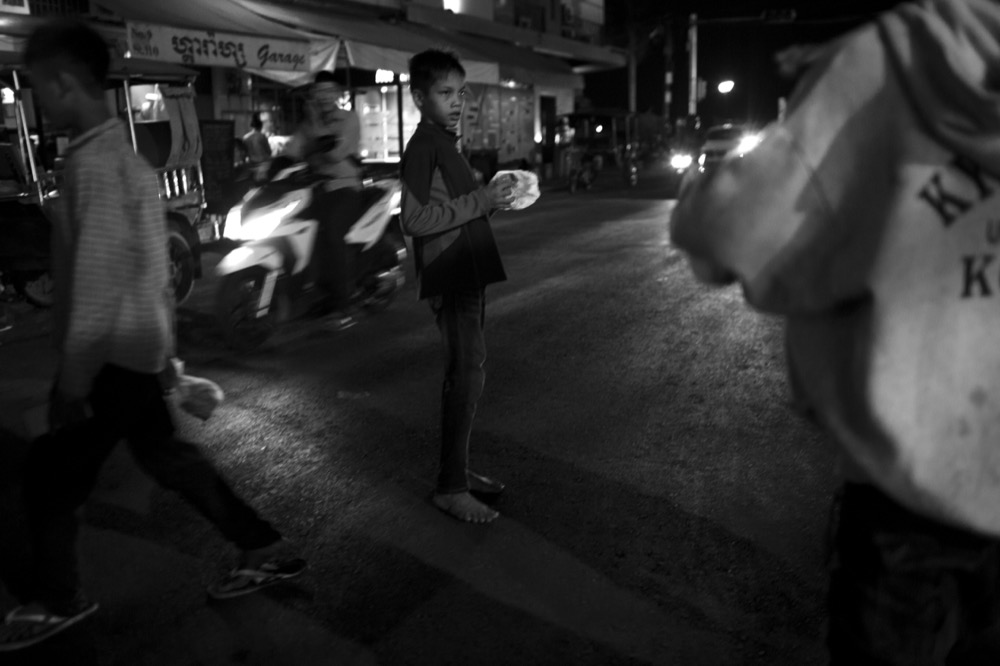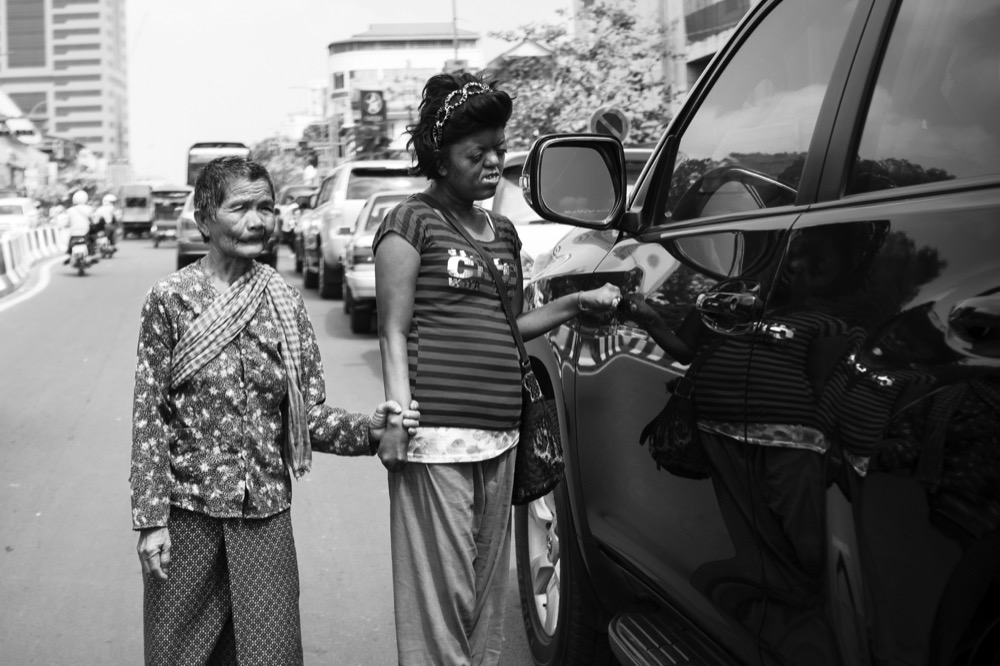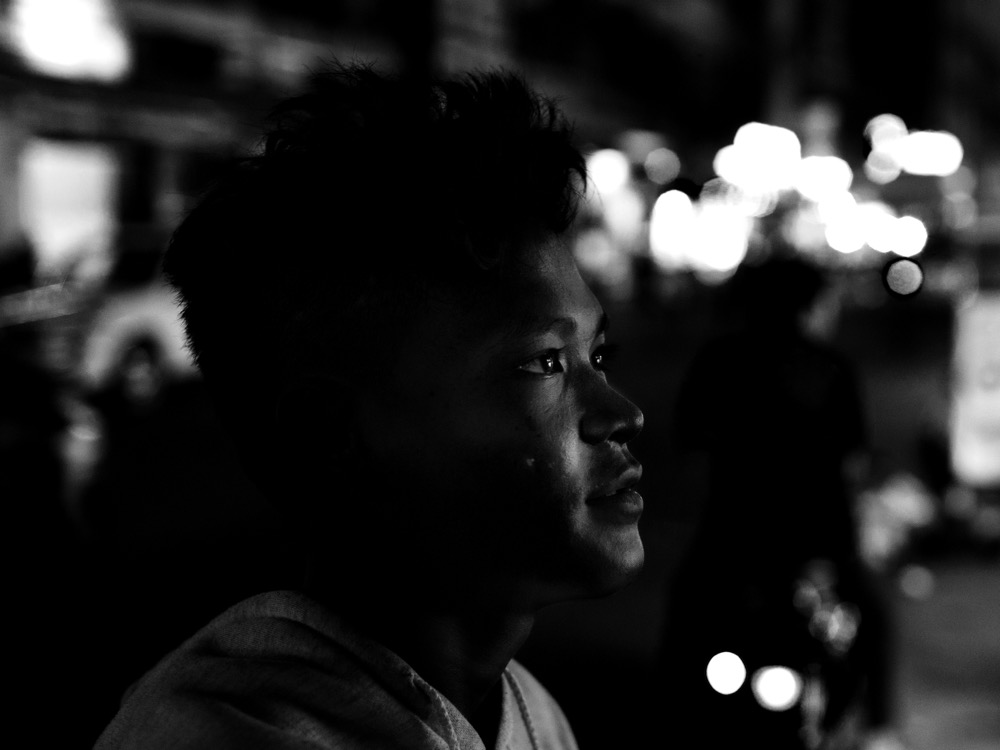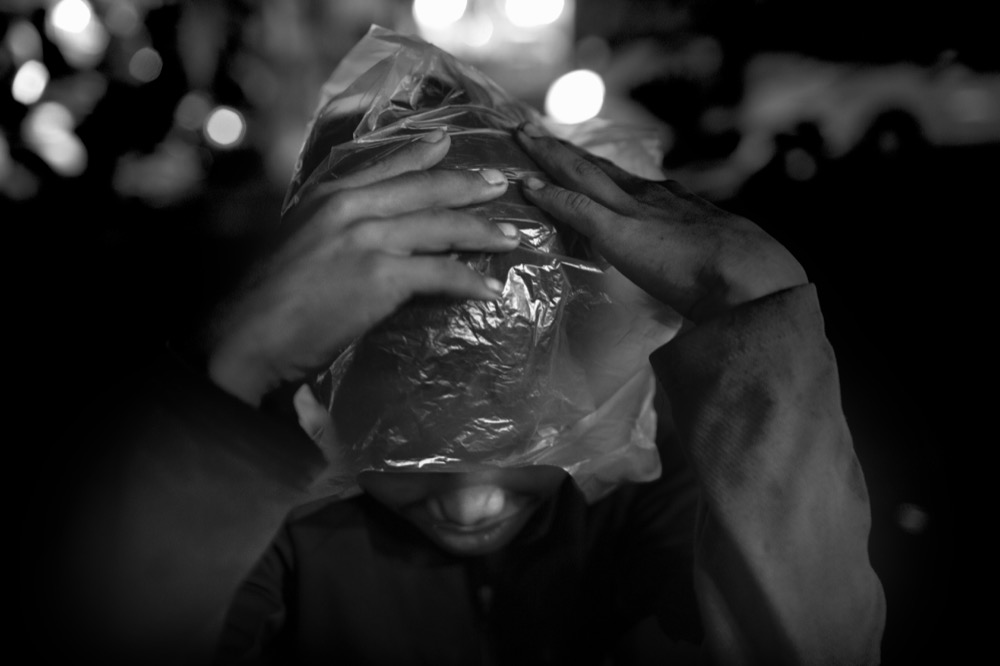 A homeless boy, high on glue, puts a plastic bag over his head on the streets of Phnom Penh last month. (Emil Kastrup/The Cambodia Daily)
A homeless boy, high on glue, puts a plastic bag over his head on the streets of Phnom Penh last month. (Emil Kastrup/The Cambodia Daily)She wanders Phnom Penh’s Street 136 for hours, trudging past girly bars, gingerly approaching tourists laughing over frosted glasses of draft beer, holding out a thin hand to passersby.
On a good night, she pockets 10,000 riel, or about $2.50. On a bad night of begging, she walks away with a few hundred crumpled riel, having spent the hours rejected or ignored.
Just 16, Soeun Srey barely scrapes by on the streets of the capital, one of nearly 2,700 teens between 13 and 17 years old whom a recent report identifies as homeless or living in inadequate housing in Cambodia’s major cities.
Among those, 65 percent are boys, according to the report by New York’s Columbia University in collaboration with the Cambodian National Institute of Statistics and Friends International, a child protection NGO based in the capital.
But fewer teenage girls living on the streets is not necessarily a reflection of better circumstances. At that age, they are more noticeable and more vulnerable to sex traffickers, the researchers say.
Cambodia’s cities are a beacon of opportunity for youths from poor, rural families, who flock to Phnom Penh and Siem Reap for construction contracts, tourism jobs or to beg on the streets.
“People coming from rural situations are very vulnerable, because they don’t know how to exist in the city,” said James Sutherland, international communications coordinator for Friends International.
“It’s a very different place,” he said. “It may be the opportunity to make more money, but the risks are so much greater.”
For Srey, a former drug user who has been sleeping on the streets of Daun Penh district’s Phsar Chas commune for two years, danger is everywhere. More than once, she has been attacked while sleeping. Older homeless boys, high on glue fumes, sometimes find her resting place, kick her, stomp on her head and steal her money.
For a while, she used ice—the street name for a potent form of crystal methamphetamine—but it made her feel weird and paranoid, and “people used to say bad things about me,” she said.
Small for her age, she makes an effort to appear presentable, with a clean navy flannel shirt and her hair pulled back off her face. She’s articulate and confident as she talks of a better future one day, when she has her own salon where she can style hair or paint nails in pretty colors. She still has hope.
In another part of the city, life is improving a little for 17-year-old Rath Pany. Until a few days ago, she was also begging on the streets, but now sells vegetables for vendors along Mao Tse Toung Boulevard, making between 10,000 and 20,000 riel a day, or about $2.50 to $5.
“I felt shy asking for money along the streets,” she said.
On a good day, she can afford a cheap meal, but when there’s not enough money to feed her family—her mother, siblings and a young niece—she goes hungry.
If she could return to rural Kandal province—from which her family of seven fled after her mother’s microfinance loan reached an unpayable $3,000—Pany said she might be able to start a wedding makeup business or open a grocery store.
“To improve my life, I need someone to help me, to provide me some money to run the business,” she said.

A homeless boy stands in the street in Phnom Penh. (Emil Kastrup/The Cambodia Daily)
Her extended family sleeps on the pavement in front of houses near the intersection of Mao Tse Toung and Monireth boulevards, until homeowners chase them away. They use restrooms in a nearby market to keep clean.
Life in the countryside “seems easier than here,” Pany said. Yet, like many of the other homeless teenagers and young adults living on Phnom Penh’s streets, she sees no other options.
NGOs and government officials are gleaning more information about homeless adolescents in Cambodia’s cities with the help of studies such as the one by Columbia University. Reasons for homelessness are complex and varied. While poor families may send their young children to an orphanage to relieve the financial strain, older ones search for jobs to support their families, Mr. Sutherland said.
Others spend their childhoods in for-profit orphanages and find themselves cast away when they are teenagers and no longer “cute” enough for prospective visitors, said his colleague, Vuthy Sokanha, communications coordinator for Friends’ Cambodia team.
When jobs and opportunities aren’t forthcoming or fall through, many homeless or poor teenagers and young adults turn to begging. Uneducated and ill-prepared for the adult world, many said they have no other choice. They choose locations brimming with tourists, like Phnom Penh’s Riverside and Phsar Chas’ bars and nightclubs. They hover at major intersections lined by sidewalks and boulevards, wiping the hoods of cars with grey feather dusters.
Kong Sreynak doesn’t know how long she’s been in the big city, only that it seems like a very long time, probably several years since she left her home in Kandal province to earn money for her mother.
The young woman, whose hands, feet and face are deformed, is not sure how old she is now—perhaps 20 or 21. Unable to read, write or work in a factory, she turned to the streets.
At the intersection of Sihanouk and Monivong boulevards, Sreynak lopes between cars and motorbikes stopped at the intersection, holding her arms outstretched to the rolled-up windows. Drivers pointedly look away.
With drooping eyes, a mouth locked in a grin, and sparse blackened teeth, she pleads for help. Sometimes, a driver will partially roll down the window and hand over small bills—100 riel or the odd 500 riel note, which she tucks away in a tattered black cloth purse.
From these meager handouts, she can save up to $30 a week. Every weekend, she makes the journey back to Kandal to see her mother.
With her leopard print headband and dirty faded pink sandals embossed with the word “Love,” Sreynak is endearingly childlike, and the older women on the streets have taken her under their wing.
For the NGOs and the government, keeping track of the city’s itinerant population is no easy task. A pavement that provides a home one week will be abandoned the next, as another location becomes more appealing or district guards clear a begging hot spot.
NGOs do their best to help—from providing shelter to reuniting homeless youths with their families, or simply offering advice on staying clean or healthy.
They’re not the only ones keeping an eye out for Phnom Penh’s young and homeless.
Security guard Ung Rotha, 29, keeps watch every night as adolescents and adults haunt the food vendors and pristine boulevard in front of the NagaWorld casino and hotel, scrounging for tattered riel notes in the shadow of the opulent building, where rooms can start at $150-a-night and high-rolling rich Chinese clients burn through dollars in the casino.
According to Mr. Rotha, a short man with slicked hair and polished black shoes, the homeless in the area he patrols bordering Daun Penh and Chamkar Mon districts can make up to 50,000 riel, or about $12.50, in one night on the strip.
Employed by the local Chamkar Mon district authority, it’s his job to keep an eye out for beggars.
“After we leave, they all come back,” he said.
Decked in khaki fatigues dotted with multiple badges, Mr. Rotha and a group of five other men kick up their feet and lounge around a pickup truck, eating noodles as dusk falls on the bustling traffic of the mainland side of Koh Pich Street.
The badges and military-looking uniforms are merely symbolic. Mr. Rotha said the guards do not have authorization to do anything other than alert district authorities when trouble arises.
District patrols will then swoop in and round up the begging children and transport them to district authorities or NGO-run emergency centers.
It’s often a waste of time. When district officials recently brought nine children from the street to the children’s rights NGO Pour un Sourire d’Enfant, all of them ran away from the shelter within two nights, said Seng Sokmean, an assistant in the social department of the NGO known in English as For a Child’s Smile.


Top: Kong Sreynak at the intersection of Monivong and Sihanouk boulevards. Middle: Chan Socheat, a homeless 18-year-old. Bottom: Chan Socheat’s companion plays with a plastic bag used to sniff glue. (Emil Kastrup/The Cambodia Daily)
Rather than forcing young adults into shelters, child welfare NGOs such as Friends leave the choice up to the homeless teens, Mr. Sutherland said.
The team will offer medical services and advice on hygiene—showing adolescents how to clip their fingernails—or give clean needles to those who do drugs. They help them access schools, shelters or job training.
“If they choose to remain on the streets, we’re still there for them to provide services to make sure they’re as safe as possible and they’re as healthy as possible,” he said.
Escaping the cycle of homelessness and poverty seems beyond the reach of most of these young people, many observers say. But among them, there are those who have turned their lives around.
Samreth, 26, once had no concept of the future. In a perpetual drugged haze, he had minimal motivation to change his ways. But after one incident left him unconscious and alone, he went for advice to his cousin, the one family member who would still talk to him.
“A dog will still be a dog,” Samreth’s cousin told him. “You can’t be changed into someone else. You do the same thing over and over.”
It was a turning point for Samreth, whose name has been changed to protect his job.
After three years of living on the streets, Samreth finally asked Friends International to help him stay off drugs. Within two years, he quit using, received training as an electrician and found a job installing air conditioning units in Phnom Penh’s hotels and office buildings.
He now has his own room, a television and a fan on the first floor of his family home, and he spends his evenings with the family that previously gave up on him. His brother, who once ignored him, bought him a gold watch rimmed in crystals that glisten from beneath his navy collared shirt.
Friends International reconnected 436 children with their families throughout their three Cambodia locations in 2015, according to the NGO’s most recent annual report. The process, from meeting a homeless adolescent on the streets to reuniting that teen with family, can take years,
As night falls in the city, Srey prepares to settle down for another evening sleeping on the streets, this time in the shadow of a shuttered riverside cafe. Women sit together on thin, unraveling mats, and one changes the diaper on a squirming, underweight baby. Srey sometimes sleeps among these of families, on the concrete ground with little cover other than her flannel shirt and grey leggings.
Lying awake at night, she sometimes imagines life in her home of Kampuchea Krom, the ethnically Cambodian section of Vietnam, where her mother and two siblings moved two years ago after her father died.
Srey still holds on to a little hope that one day she can be reunited with her mother. She estimates the trip south would cost about $50. She looks down as she considers this seemingly insurmountable challenge, her long tangled bangs obscuring her face.
Her talk of seeing her mother again or opening her own beauty salon seems a distant dream.
Chan Socheat harbors no such hopes. Standing with his hands thrust in the pockets of his white, dirt-stained hoodie, his trousers are ripped and his feet are bare.
The 18-year-old said he suffers sleeping on the sidewalk or in front of strangers’ homes. He feels cold every night and his exposed feet and arms are covered with a rash of raised mosquito bites.
“Sleeping in people’s front yards, people look down at us,” he said.
He spends his days begging for money, both to eat and feed his glue addiction.
As Socheat speaks, a 16-year-old who refers to himself as Khmorch, or “Ghost,” breathes into a clear plastic bag filled with glue wrapped around his left hand and hidden within his oversized blue button-down shirt, his gaunt chest expanding as he inhales.
Any dreams for Socheat’s future are stolen by the oblivion of the glue.
“There’s nothing I want,” he said after a pause, running his fingers through his fashionably cut hair—long on top, shaved to the scalp on the sides, the one aspect of his appearance that seems maintained. “When I think about the future, it gives me headache.”
With that, Socheat and his crew shuffle off, disappearing into the darkness and back to the streets.




